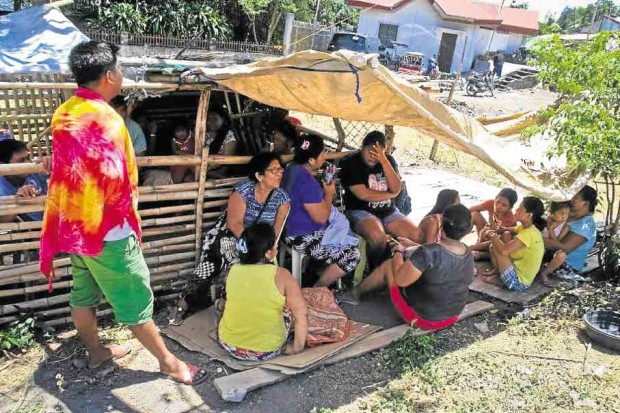
Residents afraid to stay indoors gather at a shed on a clearing in the village of Bagalangit in Mabini, Batangas, a day after the quake struck. —CHRIS QUINTANA/CONTRIBUTOR
MABINI, Batangas—After an anxious Saturday night when a 5.6-magnitude earthquake struck South Luzon, tourists have left this town, known as a diving spot, during what is normally peak season.
Most establishments, except for a few in the market, were closed on Sunday.
In the town proper, Red Cross and government emergency vehicles were seen going around, as the local government set up tents to serve as temporary offices outside the municipal building.
“We’re supposed to be closed today but we had to fix those,” a local female grocer said of the dry goods that had fallen off her store’s shelves. “If I had it my way, I would have left Mabini already.”
In the village of Anilao, a popular diving and beach resort, 15 families huddled under a tree with their pet dogs resting on bags and boxes filled with clothes. People here are still fearful and edgy.
“We’d rather stay out in the streets as there are still aftershocks,” said resident Ramil Mendoza.
“When I felt the house shake, all I could think of was to grab the image of [Our Lady of] Fatima,” said Melanie Maliglig, of Barangay Bagalangit.
Sleeping on cots
In parts of Bagalangit, an uphill village, some families plan to sleep on bamboo cots in an open area near the mountain after two concrete houses collapsed during the quake.
“You could hear loud rumbling followed by the shaking of the ground,” said Boy Ilagan, a village councilor.
“It was like the earth was going to open up,” his brother, Peter, added.
It was the first time in many years that residents here experienced a quake powerful enough to damage roads, hotels and a hospital.
Dr. Oliver Bautista said damage to Mabini General Hospital could cost millions of pesos after ceilings and walls were ripped off. The hospital was closed immediately after patients were moved to another hospital in Bauan town.
“The water in the seas receded by about two meters prompting fears of a tsunami,” Bautista said.
“As my sister said, [the earthquake] was like ripping the earth apart,” he added.
There was no common evacuation center here since residents chose to stay together in open fields or basketball courts, Mabini Mayor Noel Bitrics Luistro said.
A state of calamity had been declared as Luistro pleaded for help for the town’s 34 villages. Portable toilets, food and construction materials are badly needed, said the mayor.
Many residents sought shelter in relatives’ houses in Batangas City or elsewhere. A subvillage turned into a ghost town.
Canceled bookings
Tourists had been sent home and bookings for the Holy Week had been canceled.
Among the popular resorts with heavy damages were Camp Netanya, with walls on its top floor torn down, and the Eagle Point Beach Resort.
“We had around 200 guests, all of them sent home. One foreigner said, ‘welcome to the Philippines,’” said an employee of Eagle Point.
“That’s a problem. [Mabini is] definitely a tourist destination. We have 72 beach resorts, so just imagine [the losses] if 50 percent of those were damaged,” Mayor Luistro said.
Jeffrey Yrabon, 35, poses in front of the wreckage of his house on the hills of Barangay Bagalangit in Mabini town, Batangas, which was near the epicenter of the quake. —CHRIS QUINTANA/CONTRIBUTOR
Townsfolk have a reason to be fearful. The Philippine Institute of Volcanology and Seismology said at least 200 aftershocks with magnitudes of 3 to 4 were recorded since the quake swarms struck on April 4.
The government has started to distribute blankets, bottled water and tents to towns in Batangas province struck by the quakes.
In a report to the Palace, Social Welfare Secretary Judy Taguiwalo said the initial response was to distribute these items to families.
In Mabini, 30 tents, 600 blankets and 400 bottles of water had been distributed. In the town Tingloy, 15 tents, 200 blankets and 100 bottles of water had been distributed.
The Department of Social Welfare and Development also distributed 20 tents to hospitals, 5,000 meals and 10,000 cans of energy drinks.
Disruptions
Mary Jane Velasco, 27, was in Dubai at work when she learned about the quake. Her mother, Mely, 65, was at home in Taal town.
Failing to contact her mother through Facebook, she got in touch with a brother working in Italy, who was able to call Mely, who turned out to be OK.
The quake had disrupted power and internet lines in parts of Batangas.
Mely and a grandson, Lexus, 17, rushed out of their home in Taal, which was being renovated at the time of the quake.
Mary Jane said she knew her mother and nephew were familiar with quake drills but were unable to perform these.
“They rushed out of the house because it was mostly glass,” Mary Jane said.
Disaster-proof shelters
At the House of Representatives, legislators asked the chamber to use its oversight powers to check compliance with the National Building Code, especially in Batangas.
Two legislators seized the chance to lobby for their bills.
Bayan Muna Rep. Carlos Isagani Zarate said the bill he filed, seeking the creation of disaster-resilient evacuation centers, would help in a more systematic way of moving people out of harm’s way.
Schools and village halls would no longer be converted into evacuation centers under Zarate’s bill.
Another party-list legislator, Rep. Rodel Batocabe of Ako Bicol group, said his bill, seeking inclusion in school curricula of disaster preparedness, would answer the need for awareness about what to do during quakes or other natural disasters.
Batocabe also called on schools to prepare for the “Big One,” a quake of magnitudes that could reach 7 or higher and may strike at the West Valley Fault in Metro Manila. —WITH REPORTS FROM VINCE NONATO, CHRISTINE AVENDAÑO AND DONNA PAZZIBUGAN